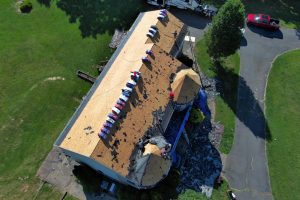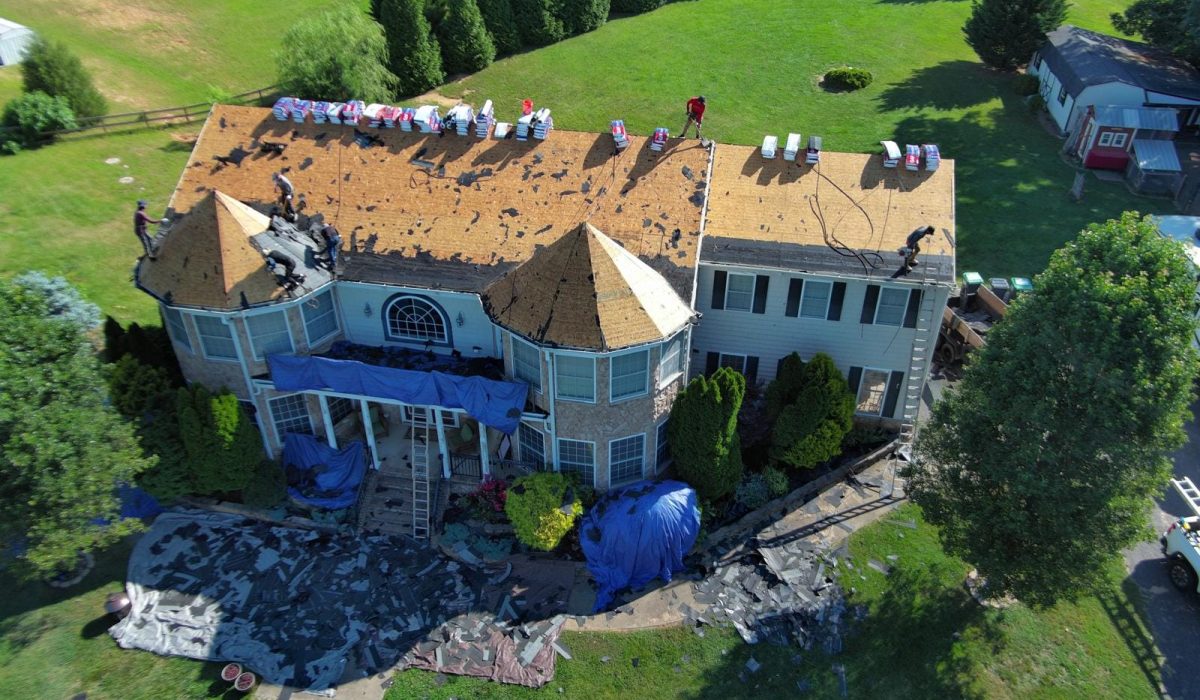- By Sydni
- Construction Blog
- 0 Comment
The Dangers of Roofing
Roofing is a vital service that protects homes and buildings from the elements, but it’s also one of the most hazardous jobs out there. While homeowners might only think about their roofs during a leak or storm, roofing contractors face significant dangers every day, from roof inspections to full-scale installations. Let’s dive into the risks roofing professionals encounter on the job and why their expertise is invaluable in keeping your home safe and secure.
1. The Hazards of Roof Inspections:
Height and Fall Hazards: Roof inspections are a crucial part of maintaining a healthy roof, but they’re also fraught with danger. The most obvious risk is the height at which roofers work. Whether it’s a single-story home or a multi-story building, being several feet off the ground presents a serious fall hazard. Even with proper safety equipment like harnesses and ropes, the risk of falling is always present, particularly on steep or slippery surfaces.
- Unstable Surfaces: Roofs can be unpredictable. A roof that looks solid from the ground might have weak spots, loose shingles, or hidden rot that can give way underfoot. Stepping on an unstable section of a roof can lead to sudden falls or slips, putting roofers in immediate danger.
- Weather Conditions: Weather adds another layer of complexity to roof inspections. Wet, icy, or windy conditions can make roofs even more treacherous. Roofing contractors often have to work in less-than-ideal weather to meet deadlines or respond to emergency repairs, increasing the risk of accidents.
2. Risks During Roof Repairs and Maintenance:
- Electrical Hazards: When working on or near roofs, roofers are often in close proximity to power lines. Accidental contact with live wires can lead to severe electrical shocks or even electrocution. Even seemingly minor tasks, such as nailing down shingles, can become dangerous if power lines are nearby.
- Exposure to Harmful Materials: Roofing often involves working with or around materials that can be harmful if not handled properly. For instance, older roofs may contain asbestos, which poses significant health risks if disturbed and inhaled. Additionally, roofers may be exposed to chemicals used in roofing materials, adhesives, and sealants, which can be hazardous if proper safety precautions aren’t taken.
- Heavy Lifting and Repetitive Strain: Roof repairs often require lifting heavy materials like shingles, rolls of roofing felt, or large sheets of metal. Repeated lifting and carrying can lead to strains, sprains, and long-term muscle issues. Roofers must also work in awkward positions for extended periods, increasing the risk of back injuries and repetitive strain.
3. Installation Dangers:
 Working at Extreme Heights: Roof installation is one of the most dangerous aspects of roofing. Contractors working on multi-story buildings or steep-pitched roofs face extreme heights that magnify the risks of falling. Even with scaffolding and safety nets, the danger remains high, particularly when installing large, heavy roofing materials.
Working at Extreme Heights: Roof installation is one of the most dangerous aspects of roofing. Contractors working on multi-story buildings or steep-pitched roofs face extreme heights that magnify the risks of falling. Even with scaffolding and safety nets, the danger remains high, particularly when installing large, heavy roofing materials.
- Handling Power Tools: Roof installation requires the use of various power tools, such as nail guns, saws, and drills. These tools, while essential, come with inherent risks. Misuse, malfunction, or distraction can lead to severe injuries, including cuts, puncture wounds, and amputations.
- Heat and Sun Exposure: Installing a roof under the hot sun can lead to heat exhaustion or heat stroke, especially during the summer months. Roofers are often exposed to the sun for hours on end, with little to no shade. Additionally, the materials they work with, such as tar and shingles, can reach extreme temperatures, adding to the risk of burns and overheating.
Roofing Debris and Falling Objects: During roof installation, there’s a constant risk of debris falling from the roof, both for the roofers and anyone on the ground. Roofers must carefully navigate around and manage these materials to prevent injuries. Moreover, loose tools or materials can slip and fall, posing serious risks to those below.
4. The Importance of Safety Training and Equipment:

Given the numerous dangers roofing contractors face, safety training and proper equipment are absolutely essential. Roofers undergo rigorous training to handle the various hazards associated with their job. This includes learning how to use safety harnesses, ladders, and scaffolding properly, as well as how to recognize and mitigate risks on the job site.
5. Why You Should Trust the Professionals:
Understanding the dangers that roofing contractors face every day underscores why it’s so important to hire professionals for your roofing needs. Roofing isn’t just about installing shingles or fixing leaks; it requires expertise, experience, and a deep commitment to safety. When you work with a professional roofing contractor like Insured Roofs, you’re not just paying for a service – you’re investing in the safety, durability, and integrity of your home.
Roofing is a demanding and dangerous job that requires skill, knowledge, and an unwavering focus on safety. From inspections to repairs and installations, roofing contractors face numerous risks daily to ensure your home remains protected. By understanding these dangers, homeowners can appreciate the value and expertise that professional roofers bring to the table. At Insured Roofs, our team is trained and equipped to handle these challenges, ensuring that your roof is installed or repaired with the utmost care and professionalism. When it comes to your home’s roof, trust the experts who put their safety on the line to keep you safe and secure.

